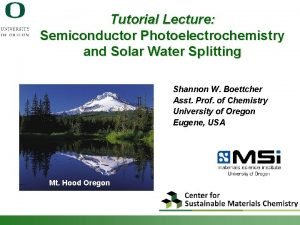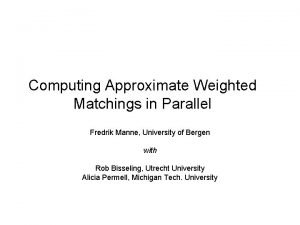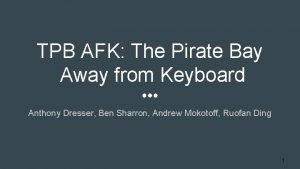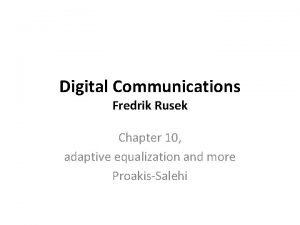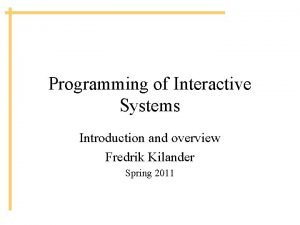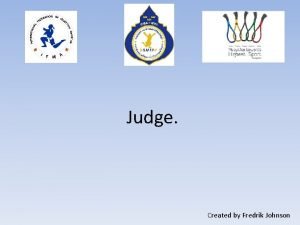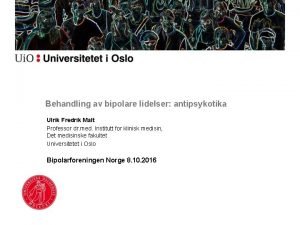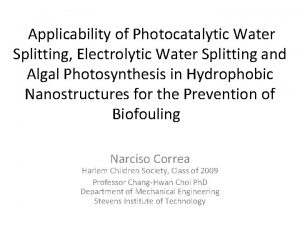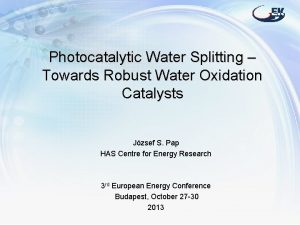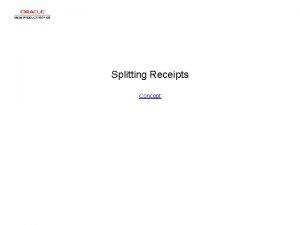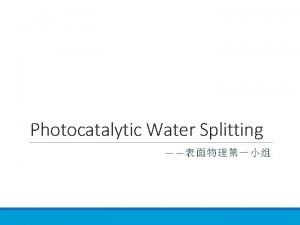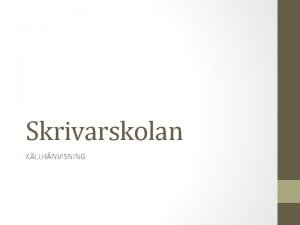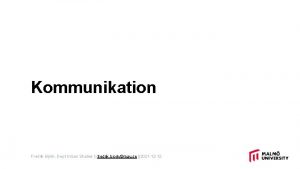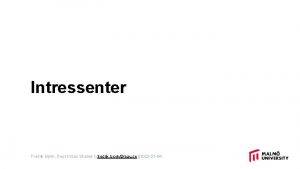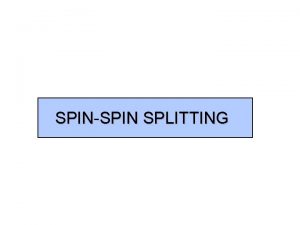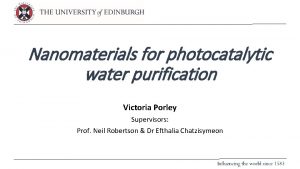New Materials for Photocatalytic Water Splitting Fredrik Skullman












- Slides: 12

New Materials for Photocatalytic Water Splitting Fredrik Skullman MATRL 286 G UCSB, 5/26/2010 Instructor: Ram Seshadri

New Materials for Photocatalytic Water Splitting, Fredrik Skullman, MATRL 286 G, 05/26/2010 Background – Why hydrogen? §Clean – no greenhouse gases §Energy security – can be produced from abundant sources §Economic growth §Efficient – fuel cells ~75% efficiency §Portable: Car tanks, micro fuel cells… Honda FCX Clarity

New Materials for Photocatalytic Water Splitting, Fredrik Skullman, MATRL 286 G, 05/26/2010 Problem §Need to build up infrastructure §Safety concerns §Production today – 95% from natural gas which is not renewable and produces CO 2 as a byproduct §Solution – Split water with renewable energy sources

New Materials for Photocatalytic Water Splitting, Fredrik Skullman, MATRL 286 G, 05/26/2010 Process H 2 O→ 2 H 2+O 2 ∆V=1. 23 V, ∆ G=238 k. J/mol §Step 1: Photon with energy above 1. 23 e. V (λ<~1000 nm) is absorbed. §Step 2: Photoexcited electrons and holes separate and migrate to surface. §Step 3: Adsorbed species (water) is reduced and oxidized by the electrons and holes. Domen et al. New Non-Oxide Photocatalysts Designed for Overall Water Splitting under Visible Light. J. Phys. Chem. 2007

New Materials for Photocatalytic Water Splitting, Fredrik Skullman, MATRL 286 G, 05/26/2010 Photocatalyst material requirements §Band gap: Band gap>1. 23 e. V and sufficiently small to make efficient use of solar spectrum (~<3 e. V). Band levels suitable for water splitting. §High Crystallinity: Defects can act as recombination sites. §Long term stability: Charge transfer used for water splitting and not corrosion. Domen et al. New Non-Oxide Photocatalysts Designed for Overall Water Splitting under Visible Light. J. Phys. Chem. 2007

New Materials for Photocatalytic Water Splitting, Fredrik Skullman, MATRL 286 G, 05/26/2010 d 0 and d 10 metal oxides Domen et al. New Non-Oxide Photocatalysts Designed for Overall Water Splitting under Visible Light. J. Phys. Chem. 2007 d 0 §Ti 4+: Ti. O 2, Sr. Ti. O 3, K 2 La 2 Ti 3 O 10 §Zr 4+: Zr. O 2 §Nb 5+: K 4 Nb 6 O 17, Sr 2 Nb 2 O 7 §Ta 5+: ATa. O 3(A=Li, Na, K), Ba. Ta 2 O 6 §W 6+: AMWO 6 (A=Rb, Cs; M=Nb, Ta) d 10 §Ga 3+: Zn. Ga 2 O 4 §In 3+: AIn. O 2 (A=Li, Na) §Ge 4+: Zn 2 Ge. O 4 §Sn 4+: Sr 2 Sn. O 4 §Sb 5+: Na. Sb. O 7

New Materials for Photocatalytic Water Splitting, Fredrik Skullman, MATRL 286 G, 05/26/2010 d 0 and d 10 metal oxides d 0 + §Layered perovskites with reaction sites between the layers. For example: K 2 La 2 Ti 3 O 10, K 4 Nb 6 O 17, ATa. O 3(A=Li, Na, K) §Band gap between O 2 p and d 0 usually too big. d 10 + §Conduction band with disperse s and p orbitals gives higher mobility. §Still usually a large band gap Domen et al. Recent progress of photocatalysts for overall water splitting. Catalysis today. 1998

New Materials for Photocatalytic Water Splitting, Fredrik Skullman, MATRL 286 G, 05/26/2010 Solution 1: Introduce Nitrogen Domen et al. New Non-Oxide Photocatalysts Designed for Overall Water Splitting under Visible Light. J. Phys. Chem. 2007 §N replaces O in certain positions, providing a smaller band gap. §Currently problems with getting the nitrogen there without too many defects. §Oxygen free options: Ta 3 N 5, Ge 3 N 4

New Materials for Photocatalytic Water Splitting, Fredrik Skullman, MATRL 286 G, 05/26/2010 Solution 2: Introduce Sulfur Sm 2 Ti 2 S 2 O 5, Ruddlesden. Popper layered perovskite §Introduce higher S 3 p bands §Band gap: 2. 1 e. V (λ= 590 nm) §Stable during photocatalysis §Still only 1. 1% quantum efficiency Domen et al. Novel Synthesis and Photo. Catalytic Activity of Oxysulfide Sm 2 Ti 2 S 2 O 5. Chem Mater. 2007

New Materials for Photocatalytic Water Splitting, Fredrik Skullman, MATRL 286 G, 05/26/2010 d 10 (oxy)nitrides §Ga. N-Zn. O (Ga 1 -x. Znx)-(N 1 -x. Ox) solid solution with Ru. O 2 nanoparticles §Wurtzite structure with similar lattice parameters §Band interactions give smaller band gap than for the individual semiconductors. §Bandgap 2. 4 -2. 8 e. V §Similar material: Zn. Ge. N 2 -Zn. O Domen et al. Overall Water Splitting on (Ga 1 x. Znx)(N 1 -x. Ox) Solid Solution Photocatalyst: Relationship between Physical Properties and Photocatalytic Activity. J. Phys. Chem. 2005

New Materials for Photocatalytic Water Splitting, Fredrik Skullman, MATRL 286 G, 05/26/2010 Conclusions §Clean, cell-free hydrogen production possible §State of the art: A few percent quantum efficiency §Plenty of room for improvements §Large area and a lot of catalysts needed→ expensive §Other water splitting options currently far more efficient Bruce et al. Self-organized photosynthetic nanoparticle for cellfree hydrogen production. Nature Nanotechnology. 2009

New Materials for Photocatalytic Water Splitting, Fredrik Skullman, MATRL 286 G, 05/26/2010 Questions?

